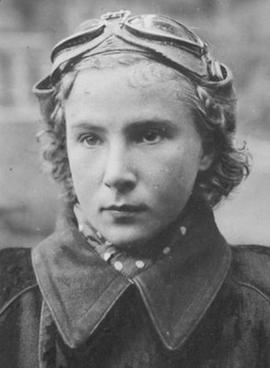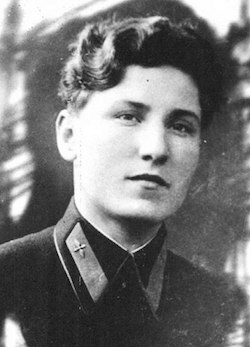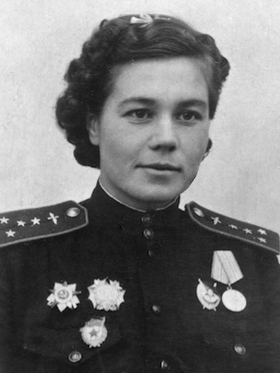
Marina Mikhaylovna Raskova was the first woman in the Soviet Union to achieve the diploma of professional air navigator. Raskova went from a young woman with aspirations of becoming an opera singer to a military instructor to the Soviet's first female navigator. She was the navigator to many record-setting as well as record-breaking flights and the founding and commanding officer of the 587th Bomber Aviation Regiment, which was renamed the 125th M.M. Raskova Borisov Guards Dive Bomber Regiment in her honor. Raskova became one of over 800,000 women in the military service, founding three female air regiments, one of which eventually flew over 30,000 sorties in World War II and produced at least 30 Heroes of the Soviet Union.

Lydia Vladimirovna Litvyak, also known as Lilya, was a fighter pilot in the Soviet Air Force during World War II. Historians estimate for her total victories range from thirteen to fourteen solo victories and four to five shared kills in her 66 combat sorties. In about two years of operations, she was the first female fighter pilot to shoot down an enemy aircraft, the first of two female fighter pilots who have earned the title of fighter ace and the holder of the record for the greatest number of kills by a female fighter pilot. She was shot down near Orel during the Battle of Kursk as she attacked a formation of German aircraft.

Yekaterina Vasilyevna Budanova, nicknamed Katya (Катя), was a fighter pilot in the Soviet Air Force during World War II. Usually credited with five or more aerial victories, along with Lydia Litvyak, she is often considered one of the world's two female fighter aces. She was shot down by either Luftwaffe ace Georg Schwientek of JG 52 or ace Emil Bitsch, of JG 3.

Women have been serving in the military since the inception of organized warfare, in both combat and non-combat roles. Their inclusion in combat missions has increased in recent decades, often serving as pilots, mechanics, and infantry officers.

"Night Witches" was a World War II German nickname for the all-female military aviators of the 588th Night Bomber Regiment, known later as the 46th "Taman" Guards Night Bomber Aviation Regiment, of the Soviet Air Forces. Though women were officially barred from combat at the time, Major Marina Raskova used her position and personal contacts with the Soviet leader Joseph Stalin to obtain permission to form female combat units. "Combat facilitated and ushered in a reluctant acceptance of women in military, based more upon practicality and necessity than for equality". On October 8, 1941, an order was issued to deploy three women's air-force units, including the 588th Regiment. The regiment, formed by Raskova and led by Major Yevdokiya Bershanskaya, was composed primarily of female volunteers in their late teens and early twenties.

Women in combat refers to female military personnel assigned to combat positions. The role of women in the military has varied across the world’s major countries throughout history with several views for and against women in combat. Over time countries have generally become more accepting of women fulfilling combat roles.

The Ukrainian Ground Forces, also referred to as the Ukrainian army, are the land forces of Ukraine and one of the eight branches of the Armed Forces of Ukraine. They were formed from Ukrainian units of the Soviet Army after Ukrainian independence, and trace their ancestry to the 1917–22 army of the Ukrainian People's Republic.

Valentina Stepanovna Grizodubova was one of the first female pilots in the Soviet Union awarded the title Hero of the Soviet Union and the only female Hero of the Soviet Union to also be awarded the title Hero of Socialist Labour.

Soviet women played an important role in World War II. While most worked in industry, transport, agriculture and other civilian roles, working double shifts to free up enlisted men to fight and increase military production, a sizable number of women served in the army. The majority were in medical units.

Irina Fyodorovna Sebrova was a flight commander in the women's 46th Taman Guards Night Bomber Aviation Regiment, also known as the Night Witches, during the Second World War. She was awarded the title Hero of the Soviet Union on 23 February 1945 for her first 825 bombing missions. By the end of the war she totaled over 1,000 sorties, more than any other female pilot.

The recent history of changes in women's roles includes having women in the military. Every country in the world permits the participation of women in the military, in one form or another. In 2018, only two countries conscripted women and men on the same formal conditions: Norway and Sweden. A few other countries have laws conscripting women into their armed forces, however with some difference such as service exemptions, length of service, and more. Some countries do not have conscription, but men and women may serve on a voluntary basis under equal conditions. Alenka Ermenc was the first female head of armed forces in any of the NATO member states, having served as the Chief of the General Staff of the Slovenian Armed Forces between 2018 and 2020.

European countries have had varying policies that confine women and military service or the extent of their participation in the national armed services of their respective countries, especially combatant roles in armed conflicts or hostile environments. While most of the countries have always allowed women to participate in military activities involving no direct aggression with the enemy, most began seeing the value of servicewomen in the armed services during the First World War when they began losing unprecedented numbers of servicemen. In the modern era, many of the European countries allow women to voluntarily pursue a career path or profession in the national armed services of their country as well as permit conscription equality, with minimal or no restrictions at all.
Latvian Riflemen Soviet Divisions were military formations of the Red Army during World War II created in 1941 and consisting primarily of ethnic Latvians.

The Armed Forces of Ukraine are the military forces of Ukraine. All military and security forces, including the Armed Forces, are under the command of the President of Ukraine and subject to oversight by a permanent Verkhovna Rada parliamentary commission. They trace their lineage to 1917, while the modern armed forces were formed after Ukrainian independence in 1991.

Raisa Yermolayevna Aronova was a Soviet Polikarpov Po-2 navigator and pilot of the 588th Night Bomber Regiment, later renamed 46th Guards Night Bomber Regiment during World War II. She received the title of Hero of the Soviet Union on 15 May 1946 for completing 914 night bombing missions against Axis forces.

Olga Aleksandrovna Sanfirova was a captain and squadron commander in the 46th Taman Guards Night Bomber Aviation Regiment during World War II. She was posthumously awarded the title Hero of the Soviet Union on 23 February 1945, making her the first Tatar woman awarded the title.

Larisa Nikolayevna Rozanova was a Soviet pilot and later the senior navigator of the 46th Taman Guards Night Bomber Aviation Regiment, nicknamed the "Night Witches" during World War II. For successfully completing 793 sorties, she was declared a Hero of the Soviet Union on 23 February, 1948.

Zoya Ivanovna Akimova née Parfyonova was a senior lieutenant and deputy squadron commander in the 46th Taman Guards Night Bomber Aviation Regiment during World War II. For completing 815 sorties during the war, she was awarded the title Hero of the Soviet Union on 18 August 1945, making her the only woman from Chuvashia to receive the title.

The 125th Borisov Guards Bomber Aviation Regiment named after Marina Raskova was one of the three Soviet women's aviation regiments founded by Marina Raskova at the start of the Second World War. The unit was founded as the 587th Bomber Aviation Regiment in the 223rd Bomber Air Division, 2nd Bomber Aviation Corps of the 16th Air Army on 8 October 1941, and later honored with the guards designation, being renamed 125th Guards Bomber Aviation Regiment in September 1943 and reorganized into 4th Guards Bomber Aviation Division, 1st Bomber Aviation Corps, 3rd Air Army, in the 1st Baltic Front. Unlike the 46th Taman Guards Night Bomber Aviation Regiment, which used Polikarpov Po-2 utility aircraft, the unit was assigned modern Petlyakov Pe-2 aircraft, which caused some resentment among male units that had older aircraft. Throughout the course of the war, the unit flew 1,134 missions and dropped over 980 tons of bombs on the Axis.
The 586th Fighter Aviation Regiment was one of the three Soviet women's aviation regiments founded by Marina Raskova at the start of the Second World War after she convinced Joseph Stalin to allow her to form three all-female aviation regiments. The regiment was originally equipped with Yakovlev Yak-1 aircraft and later acquired Yak-7 and Yak-9 aircraft in 1943. Sorties were conducted to patrol over military installations and carry out defensive missions. While the regiment was intended to be an all-female regiment it became coed with a preponderance of females after regimental commander Tamara Kazarinova transferred to another unit in October 1942 and was replaced by a man, Aleksander Gridnev. The regiment yielded two female flying aces, Lydia Litvyak and Yekaterina Budanova, who were posthumously awarded the titles Hero of the Soviet Union and Hero of the Russian Federation respectively.





















